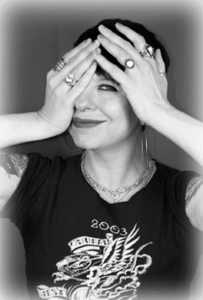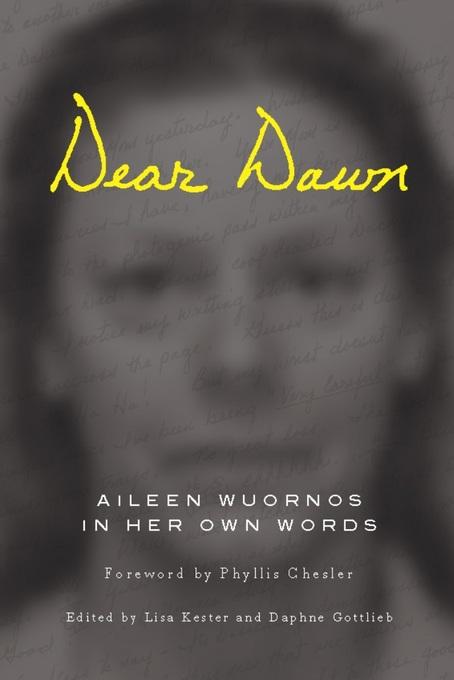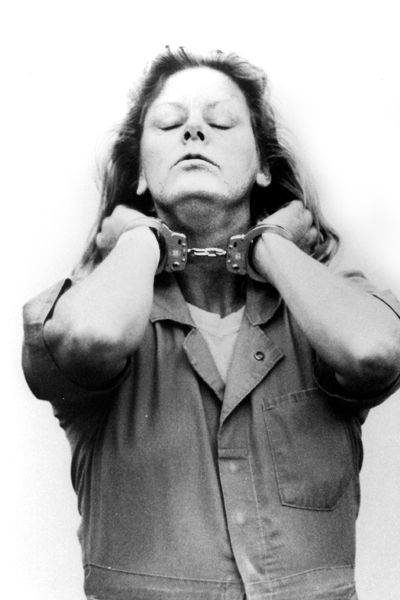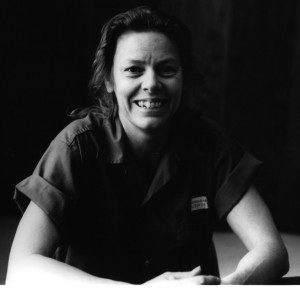
You were gang-raped, tied up, sometimes left to die, by so many boys and men, that you had to have been traumatized…No matter how tough a woman or soldier (has) to be, one does not walk away from such torture completely unscathed. —Phyllis Chesler
Bring on chilly revenge served by an armed prostitute with a hard-on for chicks. Bring on a blonde, butch, Quentin Tarantino-tinted vigilante drifter, rising from the lava with a clenched, wet fist. Bring on Aileen Wuornos.
Dear Dawn: Aileen Wuornos in Her Own Words is a collection of letters to Wuornos’s childhood friend Dawn Botkin, edited by Daphne Gottlieb and Lisa Kester. It is both empowering and heartbreaking, because Wuornos represents the fury of a wronged girl-gone-wild, whose rage was unleashed on men. She fought to survive within a system that refused to value and protect the kind of woman she was: five-feet-four inches tall. A Led Zeppelin-loving, hip-hugger-wearing hitchhiker who was raped by age fourteen and abandoned. When she became pregnant, her grandfather (who raised her) sent her away. After she gave birth, she hit the road.
The letters Wuornos wrote during her incarceration on Death Row are full of longing, laughter, and anger. As I read them, I ached for her. I also ached for the woman who was gang-raped in Delhi. I wished that Aileen Wuornos had more parental support, more love and a fighting chance in the judicial system. I wanted her to run fast to an open field outside the home for unwed mothers—far away from Death Row where she could listen to Pink Floyd in the warm sun.
***
The Rumpus: Daphne, tell me why you were attracted to Aileen’s story?
Daphne Gottlieb: I think in some ways, the same reasons as everyone—there are so many male serial killers, but who has ever heard of a female one? And a prostitute? And a lesbian?
 As far as where I was in this, in 1991, the year Aileen Wuornos was arrested, I was a year out of college and I had gotten feminism the way some people get religion. And 1991 was the year Thelma and Louise—in which two women avenge an attempted rape—was released, and the debut of Hothead Paisan: Homicidal Lesbian Terrorist, a zine by artist Diane DiMassa, about queer/feminist vengeance on the unthinking and oppressive rest of the world. So I think female vigilantism was, to some extent, already in the air, and it fit with my personal and political aesthetics. I couldn’t identify with the experience of being a homeless prostitute, but I was pretty familiar with what it is like to have your body stolen and desecrated. I wanted to go back in time and lock-and-load. I couldn’t, of course, but I took some solace and got some relief from her self-defensive shootings. I couldn’t defend myself at the time, but out there, some woman could and did.
As far as where I was in this, in 1991, the year Aileen Wuornos was arrested, I was a year out of college and I had gotten feminism the way some people get religion. And 1991 was the year Thelma and Louise—in which two women avenge an attempted rape—was released, and the debut of Hothead Paisan: Homicidal Lesbian Terrorist, a zine by artist Diane DiMassa, about queer/feminist vengeance on the unthinking and oppressive rest of the world. So I think female vigilantism was, to some extent, already in the air, and it fit with my personal and political aesthetics. I couldn’t identify with the experience of being a homeless prostitute, but I was pretty familiar with what it is like to have your body stolen and desecrated. I wanted to go back in time and lock-and-load. I couldn’t, of course, but I took some solace and got some relief from her self-defensive shootings. I couldn’t defend myself at the time, but out there, some woman could and did.
Rumpus: The early ’90s were a lush time for tough chicks, wasn’t it? I caught the same femme fatal fire at that time—seduced by feminist performance art. I loved the characters in the films you mentioned, as well as Mickey and Mallory in “Natural Born Killers” and “La Femme Nikita.” The ’90s was a time of resistance, spearheaded by female artists like Suzanne Lacy with her anti-rape billboards. I had a religious experience when I saw Diamanda Galas, with her tattooed knuckles that read “We are All HIV,” perform in the Palace of Fine Arts in San Francisco. Karen Finley’s Shock Treatment was my bible. And so I very much wanted claim Aileen Wuornos as a feminist superhero, but her story was far too sad. While reading Dear Dawn, I mostly felt sorry for her, because I think the violence and trauma she suffered shaped her actions and personality. She never had a fighting chance. She was not even given a fair trial.
Gottlieb: The thing about superheroes is that they don’t have problems, right? A feminist hooker superhero wouldn’t have to worry about assault, or pregnancy, or poverty, or disease, or eating and shelter, or police. In order to make her a superhero, you have to divorce her of the very context that makes her story possible. You have to gloss over the trauma.
There’s a widespread perception that prostitution is trauma. I guess I want to posit that prostitution was the best living that she [Wuornos] could make on her own at sixteen, when she was trying to escape sleeping in abandoned cars in freezing Michigan. The trauma, I’d argue, was with the abuse that preceded it, the poverty that she lived in, and the society that frames sex work as a moral issue and not a capitalist one.
Rumpus: Kids who are sexually abused often have survival sex later on, and I agree with what you said about Wuornos’s job choice. I don’t think prostitution equals trauma, either. According to Carl Jung, when a child is traumatized, they are in a state of confusion and terror, so they learn to disconnect and emotionally detach from themselves, causing a splitting to happen. What develops is an angry, threatened, self-debasing personality—a defensive field of swirling energy, like a black hole. The person acts out behaviors in a kind of explosive, angry way, in a desperate attempt to become whole. When I read Dear Dawn, I couldn’t help but see Aileen this way: as a kind of cataclysmic explosion due to early trauma, like a feral fourth-grader with a gun.
Gottlieb: Or a young woman with a personality disorder and a powder keg, looking for a light.
Rumpus: One striking thing about her letters was the choice you made to leave them in their most raw state, complete with spelling errors, grammatical mistakes, and funny verbal ticks like “nic nic nic” and “I’m all love!” Her voice was sometimes a pissed-off kid and sometimes very concerned for Dawn’s health and Wuornos’s ex-lovers. Her compassion came through. Was it your intention to show the ways in which Lee was a loving human being?
Gottlieb: My intention was to show Aileen, hopefully, in all her dimensions. Not as cartoon avenger, or abuse poster child, or the inevitable result of a society that condones lesbianism or any of that—but to let have a little relief. A shadow and a swell. Three-hundred-and-sixty degrees. And human.
 The thing that appealed to me the most was the chance to give her back her own words. After the thousands and thousands of words about her in the news, and thousands more in books and movies, after all the words put in her mouth, she finally had her own chance to speak. Voice is a mark of privilege in our society, and a homeless lesbian prostitute doesn’t get much airtime.
The thing that appealed to me the most was the chance to give her back her own words. After the thousands and thousands of words about her in the news, and thousands more in books and movies, after all the words put in her mouth, she finally had her own chance to speak. Voice is a mark of privilege in our society, and a homeless lesbian prostitute doesn’t get much airtime.
Rumpus: Her voice! She was such a joke-cracker and was constantly poking fun at herself and others. She loved to tell stories about her wandering hippie days, running away from home at age thirteen and fourteen. There’s a sad quality underneath it all, because she was escaping the unbearable pain of her desperate, inhumane situation. She was also very hopeful about “heaven,” and she read the Bible a lot and quoted it. Her letters were her human connection, where she could laugh with Dawn, but I kept picturing her in her cell with “death knocking on her heart.”
Gottlieb: I think that when she was writing, the sound of her pen drowned out the knocking, just for a few minutes.
Rumpus: I love that image of her writing to drown out the knocking. Her writing contained many moving images. For instance, in a letter to Dawn dated 7/17/92, she wrote: “I remember winters, when I was a runaway. Sleeping in the snow. No money, no warmth, no where to go…I looked up and saw the hills sand turning to mud sliding down at me and swirling mud around me.” That image of the world closing in on her was like a warning of her future on Death Row, but she shrugs it off: “I said screw it! And went back to sleep.”
One thing that angered me was the obstruction of justice during her trial, and the inherent sexism in the judicial system. In the ’90s, serial killers like Ted Bundy, who preyed on nearly one hundred women, were given life without parole. Aileen Wuornos was fried after a speedy thirteen-day trial. She claimed to be killing in self-defense, but society believes that whores cannot be raped. Do you think the judicial system has changed for women? For prostitutes?
Gottlieb: Not enough. Ask Savannah Dietrich, the seventeen-year-old who broke the gag order that silenced her from naming her rapists in the trial verdict. Ask those close to Brianna Gardner, Danita Brown, or Ashley Lilly, three of the 125 prostitutes murdered last year. Or ask the gang-raped sixteen-year-old girl in Steubenville.
Rumpus: Or the women who disappear every day, get shot at and raped for disagreeing with their government. In her last letter to Dawn, Wuornos says it loud and clear when she asks Dawn to “get the word out”: “How they framed a raped woman down to a serial killer, and from the get go took advantage of, in the syndrome, to beat her down to one, for secrets of their own in books and movies. Evil!” Why do you think she didn’t plead insanity? Why did she shirk a psyche evaluation during her trial? Do you think it would have helped her case?
Gottlieb: I think there are a number of reasons she didn’t plead insanity—the chief one being that she didn’t feel she was insane. When she was arrested and subsequently confessed, she said that her crimes were in self-defense. To present evidence that you are psychiatrically unstable runs counter to a self-defense plea. During the appeals, to be found insane would have meant Aileen could not have been executed, but she didn’t want to spend decades waiting to die. She wanted to go. She did not want to sit on Death Row waiting and waiting to die, watching other women get executed. She was very religious, and was ready to go to her God, believing she would be vindicated.
From her time with all sorts of institutions, and with her growing paranoia, Aileen did not trust that anyone trying to get “inside her head” had her best interests at heart. And what would a doctor want to do with her head? Prescribe? Medication is a form of control. Aileen was resistant.
Rumpus: In a recorded phone call—a sting operation—to her ex-lover Tyria Moore, she confessed that it was in self-defense, right? They used her supposed “lack of remorse” against her in court.
Gottlieb: In some ways, I feel like she was expected to do penance for the fact that she was a whore and/or that she loved women, not that she killed men. She would not repent for the court, and she was not sorry for defending herself. Semiotically speaking, it’s for this and not for the killings that the state put her to death.
Rumpus: Yes. Wuornos was resistant and mistrustful of the patriarchal system, of people who were trying to help her or profit from her crimes. For instance, one of Aileen’s victims, Mallory, was a convicted sex offender, but that never was mentioned in court! The sexist attitudes in the case and the idea that whores cannot be raped and don’t deserve protection was the thing that enraged me.
The ways in which sexism guaranteed Wuornos’s execution was explained beautifully in Phyllis Chesler’s article “Sex Death and the Double Standard”, from On The Issues Magazine. Hollywood also misrepresented her. They portrayed Aileen Wuornos as a lesbian avenger of sorts, but in her letters to Dawn, she claimed she wasn’t a “lezzie” so much as she ached for companionship. She was so hurt by men in her life, it made sense she turned to women. While reading Dear Dawn, I became wary of even the women in her life. She was very loyal to women who seemed to be her undoing: they took her money and exploited her story. Like many victims of abuse, she was terminally devoted to those who meant her harm. Am I totally off base here?
 Gottlieb: It’s true, although I’m wary of saying that she turned to women out of damage sustained from men. Plenty of women are eviscerated and still are squarely in heterosexual relationships. I do think it’s fair to say that the bodies of her female lovers were significantly different from the bodies of both those who sexually assaulted her and her clients. Whether or not that’s relevant, we’ll never know; she had at least two long-term relationships with women that she talked about, but she doesn’t self-identify as a lesbian in the letters. She had deep religious yearnings, and during her relationship with Ty, they agreed that it was a sin against God and they would live like “sisters.”
Gottlieb: It’s true, although I’m wary of saying that she turned to women out of damage sustained from men. Plenty of women are eviscerated and still are squarely in heterosexual relationships. I do think it’s fair to say that the bodies of her female lovers were significantly different from the bodies of both those who sexually assaulted her and her clients. Whether or not that’s relevant, we’ll never know; she had at least two long-term relationships with women that she talked about, but she doesn’t self-identify as a lesbian in the letters. She had deep religious yearnings, and during her relationship with Ty, they agreed that it was a sin against God and they would live like “sisters.”
Rumpus: Yes, the point is not whether or not she was a lesbian, but I think it could have downplayed the fact that her deep, sincere friendships were her lifeblood. Her religious fixation was a bit puzzling, but her love and her persistent writing was inspiring. In the forward you wrote that what mattered the most was Wuornos’s capacity to sustain an exceptional, redemptive, sisterly love for the remainder of her life until the day she was executed in 2002 after ten years on Death Row. And it’s true, that friendship and love is the thing worth living for at times.
Gottlieb: And it seems so unfair that in interviews, I always talk about Aileen, not usually Dawn, but Dawn did something just as astonishing as killing seven men. She stuck tight to a killer, without needing to excuse or condone what she did. She didn’t profit off Aileen and, for the most part, stayed out of the media circus. She was simply there for her, right to her last breath and past that, even, when she brought the ashes home and scattered them with strawberries.
***
Photograph of Daphne Gottlieb © 2013 by Joie Rey Cohen.




